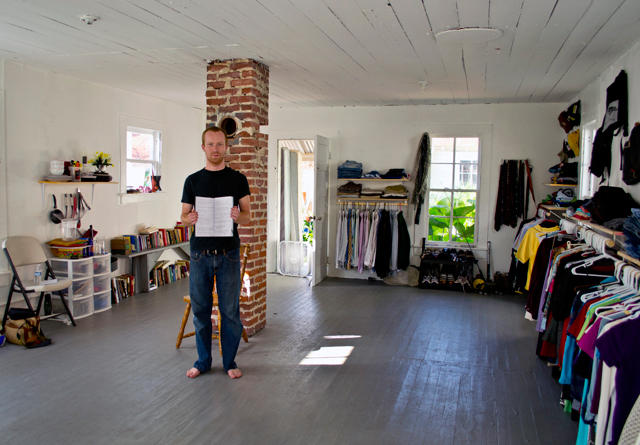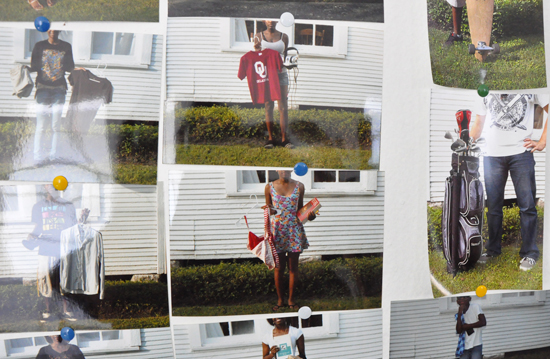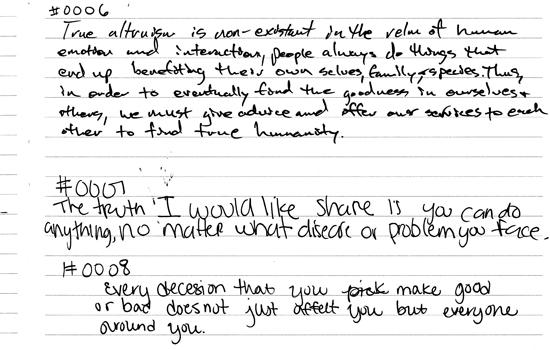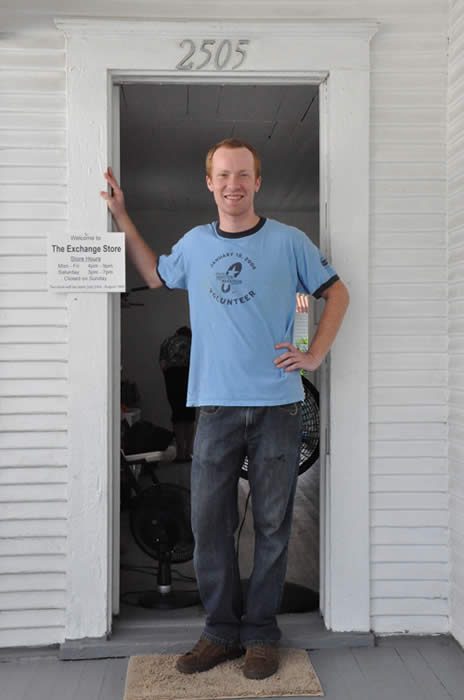Senior Exchanges Material Possessions For Mental Wisdom In Performance Art Piece
Aug. 16, 2012
SHSU Media Contact: Meredith Mohr
 |
| Josh Yates set up "The Exchange" store as a Project Row House Summer Studio Program project during which he offered guests any item of their choosing in exchange for a life lesson. More than 200 exchanges were made during the four-week project, all chronicled in a ledger that will be on display Aug. 18 through Sept. 16 in Houston. —Submitted photo |
As one of 10 students selected to present a project at one of the Houston Project Row House spaces, Sam Houston State University senior Joshua Yates decided to use the opportunity to create an environment where “truth between people would abound.”
He set up a store called “The Exchange,” which held all of his possessions—clothing, books, furniture, or anything he felt was not necessary to his existence, excluding only his dog, his car and his laptop.
Visitors were invited in and encouraged to take whatever they liked; in exchange, they were asked to leave a life lesson or truth for someone else in a journal he had set up.
As the first stage of his performance art piece wrapped up, he called what happened “a catalyst.”
“We had been open just a few days and already the response was wonderful,” Yates said. “I didn’t advertise for this at all; the news was just spread by word of mouth. There have been over 200 exchanges and 25 pages filled in the journal. The immediacy of performance art is really helping me establish a personal connection with my audience.”
Students from all over Houston were nominated by faculty for the Project Row House Summer Studio Program. After being invited to apply, nominees are required to submit a letter of intent and a detailed proposal, a professional curriculum vita, and work samples with images and video. Each artist studio ranged in materials, medium and subject matter.
“I nominated Josh for the Project Row Houses Summer Studio program because I felt like his interest in using performance art as a vehicle to engage people in places and ways that are less traditional or expected would be a nice fit for the mission of residency,” said assistant art professor at SHSU, and Yate’s thesis mentor, Annie Strader. “PRH prioritizes community engagement, and I felt like Josh would gain a great deal from the experience. His project at PRH is a thoughtful expansion of what he gained from his experience with performance art.”
 |
| Yates documented both the items that were taken as part of his exchange (above) and the words of wisdom left for him as "payment" for what was taken. —Photos by Kim Mathie |
 |
Yates, an honors student who is double majoring in studio art and photography, tried performance art at Strader’s encouragement and fell in love with the less-traditional art medium.
“It’s a kind of art that is not easily dismissed by the audience,” Yates said. “There is a direct line of communication and a transmission of energy between people. You are part of the art in performance pieces.”
Strader said that performance art is increasingly interdisciplinary, often used by artists to reach a broad audience, to blur the boundaries between traditional disciplines and to address current artistic, political and social issues of the time.
Strader, herself, is part of a performance art collaborative called “The Bridge Club,” which is currently developing a new project called “The Trailer,” an ongoing mobile installation with live performances within and outside of a trailer. The aim, Strader said, is to create “a dialogue that is regionally specific and addresses broader issues of identity, home, and displacement in the 21st century American landscape.”
“As an artist that works with various media and processes, I think performance art appeals to me because it has the distinct ability to engage people in an authentic experience by bringing art into everyday situations and to engage the viewer in a more immediate way than more static or traditional art forms,” she said.
The research Yates did for his thesis led to a series of seven or eight other projects along the same line as his most recent project, including one where he sat at a table on campus for two days with a sign that said “I am here to listen.” He only spoke in response to others; the project was about listening, observing and interacting with the world without using words.
“Including the audience in my performance like that provided an outlet for communication that they wouldn’t have had otherwise, much in the same way this project provides an outlet for truth and generosity,” Yates said.
Yates said as his mentor Strader, helped him formulate a vision for “The Exchange,” which will serve as the basis for his honors thesis, and encouraged him to think outside the box in developing this project.
 “I got the idea to do this from my father,” Yates said. “We take backpacking trips a lot together, and I learned to go out in the wilderness with everything I needed on my back. I was always surprised at how much I had that I didn’t need or had more than one of or didn’t use at all. I started thinking how I could apply that to performance art. That’s just one of the angles to this performance.”
“I got the idea to do this from my father,” Yates said. “We take backpacking trips a lot together, and I learned to go out in the wilderness with everything I needed on my back. I was always surprised at how much I had that I didn’t need or had more than one of or didn’t use at all. I started thinking how I could apply that to performance art. That’s just one of the angles to this performance.”
Through offering what he has, Yates said that this project has allowed him to receive much more than he expected, noting that his project seemed to “foster a spirit of generosity.”
“The things people have exchanged in the store seem like they really are going to help them,” Yates said. “I even had people ask if they could bring things to donate to the store. I think it’s neat that the project grew on it’s own in this way and could become a sustainable thing.”
Some of the “truths” and ideas exchanged include “determination holds no bounds,” and “you can’t allow the quiet voice of doubt within you, nor the seemingly eternal roaring of the environment that surrounds you determine the beautiful future that lies ahead of you.”
Strader said she has seen not only positive impact on the community from Yates’s project, but also creative individual development and the discovery of direction from Yates himself.
“My goal as a teacher and as an artist is to develop a sincere curiosity in my students that will cultivate and nurture their interest in the art world,” Strader said. “As a teacher, I think it is my job to locate their unique potentials and to point them in the right direction to find their passions, voices and identities as artists. When I see students such as Josh reach points of discovery and begin to self-motivate to expand their research and making beyond the expectations of the curriculum, I am electrified.”
Following graduation, Yates plans to take some time to focus on art and recharge before going on to graduate school, eventually hoping to be a professor. But this project, he said, is something he will be talking about and writing about and thinking about for a long time to come—and the things he has learned from it will continue to influence him in more than just his art.
“In every project I have the opportunity to learn a thousand new things that I didn’t know before,” Yates said. “As I head toward the future, the things I have learned from this project will stay with me as I go to design school and work in the art field, and hopefully end up teaching.
“I’m really reminded in the journal that people have so much wisdom and insight that they might not be able to share because of circumstances, but sometimes they just need an opportunity to tell it without judgment or limitation,” he said. “What I have learned from this project is largely about the power of generosity and kindness in the world by people you don’t know. It only takes a small spark of self-sacrifice and such a small beginning produces tenfold what you began with.”
Project Row Houses, a neighborhood-based non-profit art and cultural organization, comprises 40 properties, including 12 artist exhibition/residency spaces, seven houses for young mothers, artist residencies, office spaces, a community gallery, a park, and low-income residential and commercial spaces.
According to their mission statement, “art—and the community it creates—can be the foundation for revitalizing depressed inner-city neighborhoods.”
During a public viewing phase, Aug. 18 through Sept. 16, audiences can see the results of Yates’s “exchange” first-hand. Yates’s ledger and photographs of each item exchanged will be on display, and free copies of the ledger will be available, Wednesdays through Sundays from noon to 5 p.m. PRH is located at 2505 Holman St. in Houston.
- END -
This page maintained by SHSU's Communications Office
Associate Director: Julia May
Manager: Jennifer Gauntt
Located in the 115 Administration Building
Telephone: 936.294.1836; Fax: 936.294.1834
Please send comments, corrections, news tips to Today@Sam.edu.

 SamWeb
SamWeb My Sam
My Sam E-mail
E-mail

